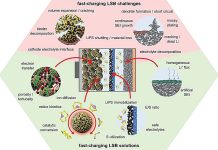
In a world constantly on the move, energy is the invisible force that powers our daily lives, from our smartphones to our cars.
The battery has become a crucial player in our modern world, especially in our pursuit of more sustainable and clean energy sources.
Researchers from Monash University and RMIT University have recently unveiled a potential game-changer in battery technology, which is not only lighter and smaller but also friendlier to both our wallets and our planet.
Meet the lithium-sulfur (Li-S) battery, a newer face in the energy storage game. Unlike its widely-used cousin, the lithium-ion battery, a Li-S battery packs more energy per gram, utilizing metallic lithium and sulfur.
Imagine having a battery that can store more energy but weighs less – it’s like having a suitcase that can magically hold more but is not any heavier to carry!
This could mean your electric car could travel further on a single charge, or your phone might need charging less frequently.
However, the Li-S battery has not been without its challenges. The conventional Li-S battery consists of a lithium anode (think of it as one battery terminal) and a sulfur cathode (the opposite battery terminal) with a layer in between.
During the charging and discharging processes, lithium and sulfur interact intensively, stressing the lithium metal significantly.
Furthermore, while lithium is a powerhouse of energy, obtaining it isn’t too kind to our planet. Extracting and transporting lithium involves processes that have notable environmental footprints, making it imperative to use as little of it as possible in our pursuit of sustainability.
Enter the innovative minds at Monash University. Ph.D. student Declan McNamara, alongside Professors Matthew Hill and Mainak Majumder from Monash Engineering and Dr. Makhdokht Shaibani from RMIT University, put their heads together to create a new twist in the Li-S battery design.
By applying a nanoporous polymer directly onto the lithium foil anode, they’ve managed to create a battery that not only requires less lithium but also boasts a longer life, more energy per unit volume, and – here’s the cherry on top – could be half the price of current lithium-ion batteries.
But what does “nanoporous polymer-coated” mean? Let’s simplify: Imagine giving the lithium a protective jacket made of a polymer (a type of plastic). This isn’t just any jacket, though.
It’s riddled with minuscule holes, each less than a nanometer in size (that’s one billionth of a meter!).
These tiny holes allow lithium ions to move about freely, while keeping out other chemicals that might damage the lithium.
Not only does this protect the lithium, but it also acts as a support, helping it to charge and discharge efficiently and repeatedly.
Mr. McNamara explains that while lithium is brimming with energy, in an ineffective battery, this energy can be wasted on unwanted side reactions.
However, when channeled correctly, lithium can facilitate impressive energy storage devices that are also simpler to produce. This innovative coating is a stride toward crafting Li-S batteries that are not only highly efficient but also easier to manufacture.
A significant boon of this new design is its independence from nickel or cobalt, thus eliminating the need for minerals that come with substantial environmental and social costs.
Professor Majumder believes these advancements signal promising steps toward a wider adoption of Li-S batteries and other lithium metal-based energy storage systems, while Professor Hill envisions this technology making an immediate impact.
He foresees the burgeoning market for electric vehicles, drones, and electronic devices greatly benefiting from research that’s ready for commercial manufacturing to support its growth.
By offering more economical and environmentally-sensitive battery options in Australia, this technology could become a key player in the ongoing global shift toward sustainable energy solutions.
In lighting up the path toward efficient and sustainable batteries, these researchers illuminate a brighter, more sustainable future where our energy is stored in ways that are kinder to our planet and our pockets.
Follow us on Twitter for more articles about this topic.



